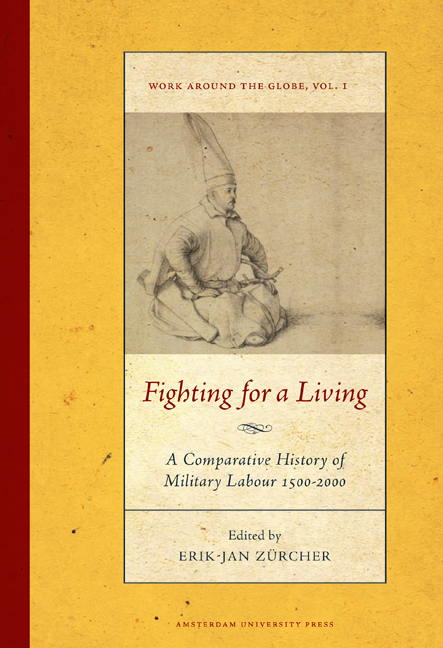Book contents
- Frontmatter
- Dedication
- Contents
- Preface
- Introduction: Understanding Changes in Military Recruitment and Employment Worldwide
- Military Labor in China, c. 1500
- From the Mamluks to the Mansabdars: A Social History of Military Service in South Asia, c. 1500 to c. 1650
- On the Ottoman Janissaries (Fourteenth-nineteenth Centuries)
- Soldiers in Western Europe, c. 1500-17901
- The Scottish Mercenary as a Migrant Labourer in Europe, 1550-1650
- Change and Continuity in Mercenary Armies: Central Europe, 1650-1750
- Peasants Fighting for a Living in Early Modern North India
- “True to Their Salt”: Mechanisms for Recruiting and Managing Military Labour in the Army of the East India Company During the Carnatic Wars in India
- “The Scum of Every County, the Refuse of Mankind”: Recruiting the British Army in the Eighteenth Century
- Mobilization of Warrior Populations in the Ottoman Context, 1750-1850
- Military Employment in Qing Dynasty China
- Military Service and the Russian Social Order, 1649-1861
- The French army, 1789-1914: Volunteers, Pressed Soldiers, and Conscripts
- The Dutch Army in Transition: From All-volunteer Force to Cadre-militia Army, 1795-1830
- The Draft and Draftees in Italy, 1861-1914
- Nation-building, War Experiences, and European Models: The Rejection of Conscription in Britain
- Mobilizing Military Labor in the Age of Total War: Ottoman Conscription Before and During the Great War
- Soldiering as Work: The All-volunteer Force in the United States
- Private Contractors in War From the 1990s to the Present: A Review Essay
- Collective Bibliography
- Notes on Contributors
On the Ottoman Janissaries (Fourteenth-nineteenth Centuries)
Published online by Cambridge University Press: 12 December 2020
- Frontmatter
- Dedication
- Contents
- Preface
- Introduction: Understanding Changes in Military Recruitment and Employment Worldwide
- Military Labor in China, c. 1500
- From the Mamluks to the Mansabdars: A Social History of Military Service in South Asia, c. 1500 to c. 1650
- On the Ottoman Janissaries (Fourteenth-nineteenth Centuries)
- Soldiers in Western Europe, c. 1500-17901
- The Scottish Mercenary as a Migrant Labourer in Europe, 1550-1650
- Change and Continuity in Mercenary Armies: Central Europe, 1650-1750
- Peasants Fighting for a Living in Early Modern North India
- “True to Their Salt”: Mechanisms for Recruiting and Managing Military Labour in the Army of the East India Company During the Carnatic Wars in India
- “The Scum of Every County, the Refuse of Mankind”: Recruiting the British Army in the Eighteenth Century
- Mobilization of Warrior Populations in the Ottoman Context, 1750-1850
- Military Employment in Qing Dynasty China
- Military Service and the Russian Social Order, 1649-1861
- The French army, 1789-1914: Volunteers, Pressed Soldiers, and Conscripts
- The Dutch Army in Transition: From All-volunteer Force to Cadre-militia Army, 1795-1830
- The Draft and Draftees in Italy, 1861-1914
- Nation-building, War Experiences, and European Models: The Rejection of Conscription in Britain
- Mobilizing Military Labor in the Age of Total War: Ottoman Conscription Before and During the Great War
- Soldiering as Work: The All-volunteer Force in the United States
- Private Contractors in War From the 1990s to the Present: A Review Essay
- Collective Bibliography
- Notes on Contributors
Summary
The janissaries are probably one of the most famous military corps in world history. Nevertheless, they were only a part of the Ottoman army and not even the most numerous one. At any period in the Ottoman history, they coexisted with a series of other military units, some of them created earlier (hence the name of yeni çeri, meaning “new troops”), others emerging in later times. All of these corps were of different natures as regards their modes of recruitment, the status of their members, their specific role in war, their method of remuneration, and so on. I shall concentrate on the corps (ocak) of the janissaries. Over several centuries, they were both a cause of terror and a source of admiration for the West, but they were also a danger for the Ottoman rulers themselves, due to their tendency to rebel. Beyond these stereotypes, one has to keep in mind that they did not offer only one face during all their long history. On the contrary, they were in a process of constant change, especially as far as their recruitment sources and military value were concerned.
Origins
The janissaries were established in the second half of the fourteenth century, probably under the reign of Sultan Murad I (there is some discussion on this point as well as on the origins of the corps in general, which remain somewhat obscure).
From the beginning, the janissary corps was an infantry unit and a standing army (which not all the infantry components of the Ottoman army were). Furthermore, its members were not free men. They were slaves, even if of a particular kind: they were slaves of the sultan (kapı kulu, hünkâr kulu). I shall return to the origins of these slaves. Initially, they were not allowed to get married. Later, at the beginning of the sixteenth century, this ban would be abolished by Sultan Selim I. From then on, there would be two kinds of janissaries, married ones and bachelors. Only the latter would continue to live in the rooms (oda) of the barracks. There is no doubt that this change was of great consequence for the nature of this army.
- Type
- Chapter
- Information
- Fighting for a LivingA Comparative Study of Military Labour 1500–2000, pp. 115 - 134Publisher: Amsterdam University PressPrint publication year: 2013
- 1
- Cited by



